|
|
Post by paleoferroequine on Mar 5, 2010 20:27:06 GMT
Sorry, mammal haters but this is a conversion of a Papo white rhino into Embolotherium andrewsi. I do have some dino projects on the back burner ;D Also finishing up on a Ampelomeryx ginsburgi   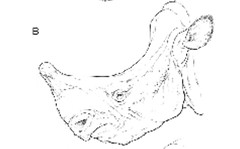 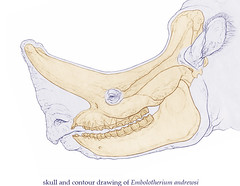 Yes, I know it looks kinda dumb with the big nose and all but this is based on the newest reconstruction.  SPECIES TAXONOMY, PHYLOGENY, AND BIOGEOGRAPHY OF THE BRONTOTHERIIDAE (MAMMALIA: PERISSODACTYLA) MATTHEW C. MIHLBACHLER 2008 |
|
|
|
Post by sumo on Mar 5, 2010 21:53:22 GMT
Looking good!  I have a special fondness for anything rhinolike... Those reference pics are great - I had no idea their muzzle projected so far beyond the skull. That really is one massive horn! |
|
|
|
Post by paleoferroequine on Mar 5, 2010 22:13:12 GMT
Looking good!  I have a special fondness for anything rhinolike... Those reference pics are great - I had no idea their muzzle projected so far beyond the skull. That really is one massive horn! That is actually the nasal cavity in front of the ram! Wang(2000) depicted the nostrils on the top of this structure although the true position of the nostrils is uncertain. I wasn't about to put them on the top like some mammalian snorkel!  That would just be really weird! If you like rhino types, did you see my conversions of Elasmotherium, Megacerops, and Teleoceras that I did earlier? |
|
|
|
Post by Griffin on Mar 6, 2010 19:15:06 GMT
Really awesome work as usual. I love how you make figures of animals never before seen in toy form a reality.
|
|
|
|
Post by [][][]cordylus[][][] on Mar 6, 2010 19:21:08 GMT
Very good!
|
|
|
|
Post by Horridus on Mar 6, 2010 19:22:06 GMT
Fantastic conversion job. We need more models of wacky prehistoric rhinos!
|
|
|
|
Post by bokisaurus on Mar 7, 2010 16:37:54 GMT
Impressive as always!  I love how you are choosing some unusual species that are interesting. Wish there was a way to get one of this from you  Keep them coming! |
|
|
|
Post by Megaraptor on Mar 22, 2010 5:01:46 GMT
Wonderful job on this one!
|
|
|
|
Post by sbell on Mar 22, 2010 13:33:47 GMT
I just can't see it in that reconstruction--I am in a place where I see brontothere skulls all day, every day.
One question--what on earth would be the adaptation to having a big projection like that, without actually expanding the region on the face--it doesn't make the horns any more useful. Plus, how does it account for the double-forked morphology (we have skulls where the two forks each fork again in turn, to create two 'Y' horns)--and they are extremely long.
|
|
|
|
Post by paleoferroequine on Mar 22, 2010 19:39:24 GMT
I just can't see it in that reconstruction--I am in a place where I see brontothere skulls all day, every day. One question--what on earth would be the adaptation to having a big projection like that, without actually expanding the region on the face--it doesn't make the horns any more useful. Plus, how does it account for the double-forked morphology (we have skulls where the two forks each fork again in turn, to create two 'Y' horns)--and they are extremely long. Well, I'll defer to you since that's your work. I just based it on the paper by Matthew C. Mihlbachler. The Embolotheriums seem to have a deep nasal channel on the front of the "ram" and he interprets that to mean a large nasal cavity. 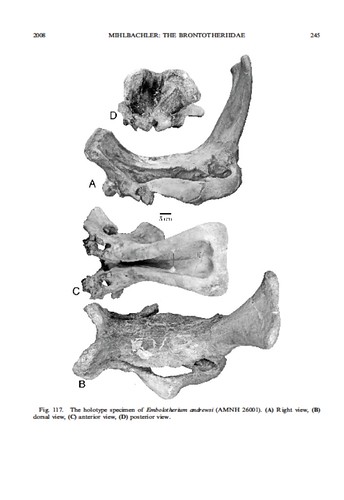 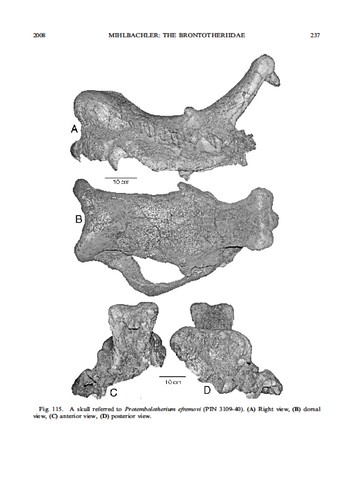 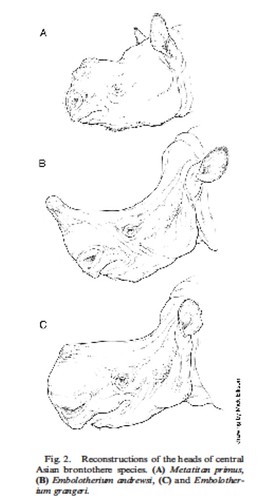 In the second image of a related species there is even the remains of the nasal process on the peak of the ram. But, this is his opinion not mine so I really don't know, I just sculpted it ;D Are the brontotheriids you see just N. American or also asian? I would love to see photos of the double horn ones! |
|
|
|
Post by sbell on Mar 22, 2010 19:57:07 GMT
I just can't see it in that reconstruction--I am in a place where I see brontothere skulls all day, every day. One question--what on earth would be the adaptation to having a big projection like that, without actually expanding the region on the face--it doesn't make the horns any more useful. Plus, how does it account for the double-forked morphology (we have skulls where the two forks each fork again in turn, to create two 'Y' horns)--and they are extremely long. Well, I'll defer to you since that's your work. I just based it on the paper by Matthew C. Mihlbachler. The Embolotheriums seem to have a deep nasal channel on the front of the "ram" and he interprets that to mean a large nasal cavity.    In the second image of a related species there is even the remains of the nasal process on the peak of the ram. But, this is his opinion not mine so I really don't know, I just sculpted it ;D Are the brontotheriids you see just N. American or also asian? I would love to see photos of the double horn ones! I don't have the skull handy for a photo, but to be clear, it is very odd--the bifurcating horns bifurcate again (it's like having two Synthetoceras nose horns stuck side by side on a brontothere skull). The only ones we have here are local North American ones--mostly Megacerops. I can't recall noticing a channel on the nasal. Embolotherium could be a unique case, but something about the proposed morphology just looks excessive, as though there are huge amounts of flesh being proposed that wouldn't really have a function--not much for enhancing smell, for example, or any other potential sense, and I can't think of a way it would give any further strength or purpose to the 'horns' either. |
|